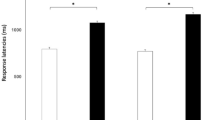Abstract
In both behavioural and brain-imaging studies, numerical magnitude comparison tasks have been used to glean insights into the processing and representation of numerical magnitude. The present study examined the extent to which eye movement data can be used to investigate the neurocognitive processes underlying numerical magnitude processing. Twenty-two participants performed a numerical comparison task (deciding which of two Arabic numerals represents the larger numerical magnitude) while eye tracking data was recorded. The ratio between numbers (smaller/larger) was manipulated and ranged from 0.11 to 0.89. Consistent with previous reaction time and accuracy studies, the present results demonstrated significant main effects of ratio on the number of fixations, as well as a significant main effect of correct (numerically larger) versus incorrect (numerically smaller) number on the duration of fixations. Furthermore, data from the present investigation also revealed that participants made significantly more saccades between the two numbers for large relative to small ratio trials. Moreover, the ratio effects on eye movements were uncorrelated with the effect of numerical ratio on reaction times, suggesting that eye tracking measures of number comparison may tap into a different level of numerical magnitude processing than reaction time measures do.
Similar content being viewed by others
References
Cantlon JF, Brannon EM (2006) Shared system for ordering small and large numbers in monkeys and humans. Psychol Sci 17(5):401–406
Dehaene S, Changeux JP (1993) Development of elementary numerical abilities: a neuronal model. J Cogn Neurosci 5:390–407
Dehaene S, Dupoux E, Mehler J (1990) Is numerical comparison digital? Analogical and symbolic effects in two-digit number comparison. J Exp Psychol Hum Percept Perform 16(3):626–641
Desroches AS, Joanisse MF, Robertson EK (2006) Specific phonological impairments in dyslexia revealed by eyetracking. Cognition 100(3):B32–B42
Fischer MH, Castel AD, Dodd MD, Pratt J (2003) Perceiving numbers causes spatial shifts of attention. Nat Neurosci 6(6):555–556
Fischer MH, Warlop N, Hill RL, Fias W (2004) Oculomotor bias induced by number perception. Exp Psychol 51(2):91–97
Moyer RS, Landauer TK (1967) Time required for judgements of numerical inequality. Nature 215(109):1519–1520
Pinel P, Dehaene S, Riviere D, LeBihan D (2001) Modulation of parietal activation by semantic distance in a number comparison task. Neuroimage 14(5):1013–1026
Van Opstal F, Gevers W, De Moor W, Verguts T (2008) Dissecting the symbolic distance effect: comparison and priming effects in numerical and nonnumerical orders. Psychon Bull Rev 15(2):419–425
Zorzi M, Butterworth B (1999) A computational model of number comparison. Paper presented at the twenty-first annual conference of the Cognitive Science Society, Mahwah
Author information
Authors and Affiliations
Corresponding author
Appendix
Rights and permissions
About this article
Cite this article
Merkley, R., Ansari, D. Using eye tracking to study numerical cognition: the case of the ratio effect. Exp Brain Res 206, 455–460 (2010). https://doi.org/10.1007/s00221-010-2419-8
Received:
Accepted:
Published:
Issue Date:
DOI: https://doi.org/10.1007/s00221-010-2419-8




